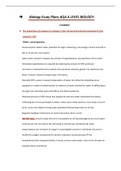è Biology Essay Plans AQA A LEVEL BIOLOGY:
(TAZM03)
1) The Importance of responses to changes in the internal and external environment of an
organism. (25)
PARA1: osmoregulation
- Osmoreceptors detect water potential too high in blood (eg: not enough mineral ions/salt in
diet or drank too much water).
- water enters osmosis receptors by osmosis in hypothalamus, causing these cells to swell.
- Stimulates hypothalamus to respond by reducing the amount of ADH produced.
- Hormone is transported and secreted at the posterior pituitary glands into capillaries and
blood. Travels in blood to target organ, the kidney.
- Normally ADH causes increased reabsorption of water into blood by imbedding more
aquaporins in walls of collecting duct at nephron, protein channels for water to diffuse/pass
through into interstitial space and diffuse into blood capillaries.
- Reducing amount of ADH menas less aquaporins and less water reabsorbed into blood.
- Collecting duct is less permeable to water, water stays inside nephron, more water is lost in
urine, urine more dilute to bring water potential of blood down back to normal
- Negative feedback mechanisms to restore deviations form a norm.
- IMPORTANCE: ensures body cells aren’t susceptible to cell lysis/damage by too much water
entering cell, this can lead to the cell losing its function eg: red blood cells loose
shape/rupture less transport of oxygen in haemoglobin present in red blood cells and so
insufficient oxygen transported for aerobic respiration and producing ATP for
metabolism/active transport/mitosis. Ensures not too much water is lost in hot climates for
example desert animals etc.
,PARA 2: plant tropisms (only choose 1 importance)
- auxins and growth factors can stimulate how plants respond to external stimuli
- IAA is a growth factor in plants, stimulate cell elongation in shoots in high concentrations
and inhibits cell elongation in cell roots when in high concentrations
- IAA produced in tips of shoots and diffuses throughout plant
- For example photo tropisms, responding to external stimuli of light
- Shoots: positive phototropism, bends towards light/stimulus. Light shone on one side of
light. IAA diffuses to shaded side of shoot. Stimulates cell elongation on shaded side causing
plant to bend more towards light.
IMPORTANCE: maximises light exposure and more light can be absorbed by chlorophyll
more electrons excited, more photolysis and LDR. For ETC ATP production and reduced
NADP for Calvin cycle essential to reduce GP to TP and use some TP for making hexose
sugars like glucose/sucrose needed for plant to use in creating plant cell walls and cellulose
polymer from Beta glucose.
- Negative phototropism: roots, bend away from light, IAA diffuses from lighter side of root to
shaded side of root, causes high concentration of IAA on bottom side of root, inhibiting cell
elongation. So cells on top side of root elongate more, root bends downwards away from
light and anchors plant into soil.
IMPORTANCE: plant needs to anchor deep in soil, access scarce ions in soil like phosphates
that are deeper in soil maximise water absorbance important for making phospholipid
bilayer, DNA/RNA ATP for metabolism, cell division. Using water in photosynthesis to
produce glucose etc.
,PARA 3: stomata opening and closing
- Stomata on bottom of leaf of plants
- How CO2 enters leaf cells by diffusion and release oxygen
- Surrounded by guard cells, control and regulate rate of transpiration by opening and closing
stomata
- Guard cells use osmotic pressure to open. Turgid, guard cell filled with water, guard cell
closes to reduce amount of water loss by transpiration, limits co2 and o2 as well.
- Flaccid, means stomata’s surrounding environment has a lower water potential, stomata
open allows more co2 in more water and o2 out
IMPORTANCE: regulating transpiration in response to humidity, light, temperature and wind
prevents excessive water loss of plant, needed as a reactant in photosynthesis and also
needed to have the ability to open and let CO2 for Calvin cycle in to produce glucose in
photosynthesis. This can then be used in respiration to produce ATP providing energy for
active transport, cell growth etc.
PARA 4: responding to internal stimuli, pathogen humoral response
- Pathogen has proteins on its surface, antigens
- Complimentary receptors on specific B lymphocytes/ white blood cells bind to antigen and
recognise as foreign/non self
- Helper T cells with specific complimentary receptors stimulate B lymphocytes to divide by
mitosis and clone
- Develop plasma cells that release large quantities of specific complimentary antibody to
antigen rapidly allowing for agglutination, attaching to many pathogen molecules, clumping
one large target of phagocytes to engulf ingest and destroy than many pathogens/targets
speeding up immune response
, - Some plasma cells develop into memory cells and circulate in blood for long term immunity
specific complimentary receptors to this antigen, ready for a greater more rapid immune
response upon a second infection
IMPORTANCE: destroying disease causing microorganisms, keeping tissues and cells healthy,
maintains their functions. More likely to survive reproduce and pass on alleles if able to
avert disease/infection more desirable mate. Better competitive position for food and
habitat if remain free of disease and harmful symptoms of disease.




